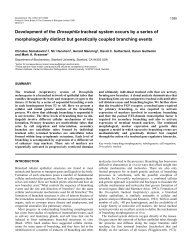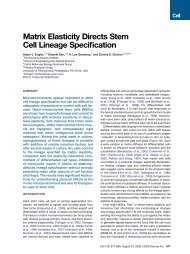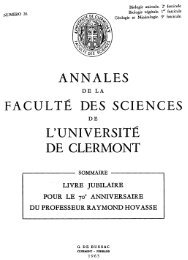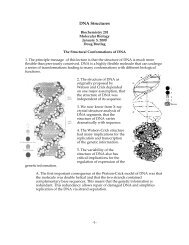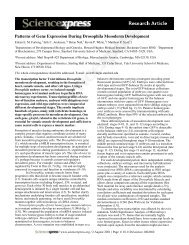Niemann-Pick C1 Like 1 Protein Is Critical for ... - Cmgm Stanford
Niemann-Pick C1 Like 1 Protein Is Critical for ... - Cmgm Stanford
Niemann-Pick C1 Like 1 Protein Is Critical for ... - Cmgm Stanford
Create successful ePaper yourself
Turn your PDF publications into a flip-book with our unique Google optimized e-Paper software.
Fig. 4. In vivo bone <strong>for</strong>mation isattributable to human cells. (Aand B)Sections from an implantseeded with an OIMS<strong>C1</strong>0 clonetargeted at the mutant allelewere stained brown with an antibodyto human mitochondriato identify human cells in thegray bone matrix. (C)Controlsection from an implant seededwith murine MSCs and stained<strong>for</strong> human mitochondria. (D)Animplant seeded with anOIMS<strong>C1</strong>0 clone targeted at themutant allele and stained withan antibody to human collagenshows brown-stained humancollagen fibrils. (E)Control implantseeded with murine MSCsand stained <strong>for</strong> human collagen.Scale bars, 25 m.11. M. J. Edwards, R. J. Wenstrup, P. H. Byers, D. H. Cohn,Hum. Mutat. 1, 47 (1992).12. G. A. Wallis, B. J. Starman, A. B. Zinn, P. H. Byers,Am. J. Hum. Genet. 46, 1034 (1990).13. R. F. Pereira et al., Proc. Natl. Acad. Sci. U.S.A. 95,1142 (1998).14. N. S. Fedarko, M. Moerike, R. Brenner, P. G. Robey, U.Vetter, J. Bone Miner. Res. 7, 921 (1992).<strong>Niemann</strong>-<strong>Pick</strong> <strong>C1</strong> <strong>Like</strong> 1 <strong>Protein</strong><strong>Is</strong> <strong>Critical</strong> <strong>for</strong> IntestinalCholesterol AbsorptionScott W. Altmann, 1 * Harry R. Davis Jr., 1 Li-ji Zhu, 1 Xiaorui Yao, 1Lizbeth M. Hoos, 1 Glen Tetzloff, 1 Sai Prasad N. Iyer, 1Maureen Maguire, 2 Andrei Golovko, 2 Ming Zeng, 2Luquan Wang, 2 † Nicholas Murgolo, 2 Michael P. Graziano 1Dietary cholesterol consumption and intestinal cholesterol absorption contributeto plasma cholesterol levels, a risk factor <strong>for</strong> coronary heart disease. The molecularmechanism of sterol uptake from the lumen of the small intestine is poorly defined.We show that <strong>Niemann</strong>-<strong>Pick</strong> <strong>C1</strong><strong>Like</strong> 1(NP<strong>C1</strong>L1) protein plays a critical role in theabsorption of intestinal cholesterol. NP<strong>C1</strong>L1 expression is enriched in the smallintestine and is in the brush border membrane of enterocytes. Although otherwisephenotypically normal, NP<strong>C1</strong>L1-deficient mice exhibit a substantial reduction inabsorbed cholesterol, which is unaffected by dietary supplementation of bile acids.Ezetimibe, a drug that inhibits cholesterol absorption, had no effect in NP<strong>C1</strong>L1knockout mice, suggesting that NP<strong>C1</strong>L1 resides in an ezetimibe-sensitive pathwayresponsible <strong>for</strong> intestinal cholesterol absorption.Whole-body cholesterol homeostasis is a highlyregulated balance of de novo synthesis, dietarycholesterol absorption, and biliary clearanceand excretion. The cholesterol biosynthetic andclearance pathways are well defined. An understandingof the biosynthetic pathway has led tothe development of the statin class of 3-hydroxy-1Department of Cardiovascular/Endocrine Research,2Department of Discovery Technologies, Schering-Plough Research Institute, 2015 Galloping Hill Road,Kenilworth, NJ, 07033–0539, USA.*To whom correspondence should be addressed. E-mail: scott.altmann@spcorp.com†Present address: GenScript Corporation, 100 MenloPark Drive, Suite 316, Edison, NJ, 08837, USA.3-methyl-glutaryl coenzyme A reductase(HMG-CoA reductase) inhibitors <strong>for</strong> the managementof hypercholesterolemia and associatedcardiovascular disease (1). In contrast, themechanisms controlling cholesterol absorptionare less well understood. The adenosinetriphosphate (ATP)–binding cassette (ABC)A1 transporter and scavenger receptor type B1(SR-BI) were postulated to play a role in intestinalcholesterol absorption (2–4), but targetedinactivation of these genes in mice had no effecton cholesterol uptake (5–7). The ABCG5 andABCG8 transporters, which are defective in thesterol absorption disease sitosterolemia, providean apparatus <strong>for</strong> efficient shunting of sterols15. N. Inoue, R. K. Hirata, D. W. Russell, J. Virol. 73, 7376(1999).16. N. Inoue, R. Dong, R. K. Hirata, D. W. Russell, Mol.Ther. 3, 526 (2001).17. D. W. Russell, R. K. Hirata, Nature Genet. 18, 325(1998).18. A. I. Caplan, J. Orthop. Res. 9, 641 (1991).19. M. F. Pittenger et al., Science 284, 143 (1999).20. D. J. Prockop, Science 276, 71 (1997).21. S. Hacein-Bey-Abina et al., Science 302, 415 (2003).22. We thank G. Priestley and T. Papayannopoulou <strong>for</strong>NOD/SCID mice; S. Heimfeld <strong>for</strong> cadaveric bone marrowcells; C. Miller <strong>for</strong> EM; D. Chen <strong>for</strong> mutationanalysis; C. Xu, R. Dong, and R. Newton <strong>for</strong> technicalassistance; and T. Kyriakides <strong>for</strong> helpful discussions.This work was supported by grants from the U.S.National Institutes of Health, the Children’s BrittleBone Foundation, and the George F. Odland ResearchFund.Supporting Online Materialwww.sciencemag.org/cgi/content/full/303/5661/1198/D<strong>C1</strong>Materials and MethodsFigs. S1 to S4Tables S1 and S2References7 July 2003; accepted 12 January 2004R EPORTSaway from the transfer pathway directing theproduction of cholesteryl esters by acyl-CoAcholesterol acyl transferase 2 (ACAT2) (8–10).However, none of these mechanisms appear tobe involved in the initial uptake of cholesterol.In humans, cholesterol absorption occurs inthe proximal jejunum of the small intestine, whereboth dietary cholesterol and biliary cholesterol areavailable <strong>for</strong> uptake from the intestinal lumen. Thesecond-order kinetics of cholesterol absorption(11), its sterol specificity (12, 13), and its inhibitionby drugs such as ezetimibe (14) all suggestthat this process is mediated by a specific transportprotein(s). However, the identity of this putativecholesterol transporter has remained elusive.To identify genes involved in cholesteroluptake, we used a genomic-bioin<strong>for</strong>matics approach.Because sequences from gastrointestinaltissues are poorly represented in the publicsequence databases, we prepared two cDNAlibraries <strong>for</strong> sequencing, one from rat jejunummucosal scrapings and the second from jejunumenterocytes isolated by laser capture microdissection(15). The 16,500 expressed sequencetags (ESTs) derived from these librarieswere combined with all available public ratESTs and were annotated by cross-referencingthe rat sequences with both mouse and humandata. This sequence database was analyzed <strong>for</strong>all transcripts containing features anticipated ina cholesterol transporter, i.e., sequences predictiveof transmembrane domains, extracellularsignal peptides, and N-linked glycosylationsites as well as known cholesterol interactingmotifs such as sterol-sensing domain (16–18).Only one credible candidate gene emerged fromthis analysis: the rat homolog of NP<strong>C1</strong>L1 (19).Human NP<strong>C1</strong>L1 has several of the predictedfeatures of a plasma membrane–expressed transporterincluding a secretion signal, 13 putativeDownloaded from www.sciencemag.org on November 12, 2007www.sciencemag.org SCIENCE VOL 303 20 FEBRUARY 2004 1201
R EPORTSFig. 1. (A)Tissue distributionof NP<strong>C1</strong>L1mRNA. Rat and mousetissue samples wereevaluated by quantitativeRT-PCR; humanmRNA was measuredby quantitative microarrayusing multipletissue samples hybridizationto the AffymetrixHG-U95 chip(Gene Logic, Gaithersburg,MD). Tissue withthe most abundantsignal was set to anormalized value of100 arbitrary units. (B)Localization of mRNAand protein along theduodenum-ileum axisof the rat small intestine.Separate animalswere used <strong>for</strong> each setof measurements. Thesmall intestine fromthe pyloric valve tothe ileacolic valve wasremoved, flushed, anddivided into 10 segmentsof equal length(10 cm)<strong>for</strong> purificationof mucosal mRNAor isolation of epithelialcells (31). Equalamounts of mRNAfrom each segmentwere subjected toquantitative RT-PCR(top), and NP<strong>C1</strong>L1 signalwas normalizedwith the enterocytespecificmarker villin.Equal amounts of totalprotein from eachsegment were analyzedby Western blotanalysis (bottom).transmembrane domains and extensive potentialN-linked glycosylation sites located within theextracellular loops of the protein. Furthermore,this protein contains a sterol-sensing domain (fig.S1), which is present in other key regulators ofcholesterol homeostasis including HMG-CoA reductase(20), SREBP cleavage-activating protein(SCAP) (16), PATCHED (21), and <strong>Niemann</strong>-<strong>Pick</strong> <strong>C1</strong> (NP<strong>C1</strong>) (22).NP<strong>C1</strong>L1 has 50% amino acid homologyto NP<strong>C1</strong> (19), a gene that is defective in thecholesterol storage disease <strong>Niemann</strong>-<strong>Pick</strong> typeC (NP-C) and functions in intracellular cholesteroltrafficking (22). However, in contrast toNP<strong>C1</strong> mRNA, which is abundantly expressedand widely distributed in many tissues (23),NP<strong>C1</strong>L1 mRNA is expressed at low levels andis enriched in the gastrointestinal tract. BlastNand E-Northern analyses of the rat, mouse, andhuman EST databases were used to estimate theabundance and tissue distribution of theNP<strong>C1</strong>L1 mRNA (GenBank accession numbersAY437865, AY437866, and AY437867). Inthe rat, only 4 of 289,849 available ESTs—three of which were from the jejunum librariesdescribed above—encoded NP<strong>C1</strong>L1. In themouse, 10 of 2,170,430 ESTs encodedNP<strong>C1</strong>L1, 6 of which were from intestine, 2from cecum, and 2 from embryo. The humanEST database contained 6 NP<strong>C1</strong>L1 ESTs out of9,274,986 total (2 from pancreas, 2 colon, 1gallbladder, and 1 fetal liver or spleen).We assessed NP<strong>C1</strong>L1 mRNA expression in15 tissues from rat, mouse, and human using bothquantitative reverse transcriptase–polymerasechain reaction (RT-PCR) and microarray hybridization(Fig. 1A). Northern blot analysiswas inconclusive because of the low levels ofNP<strong>C1</strong>L1 mRNA and because NP<strong>C1</strong> mRNAcross-reacted with the labeled probe (24). In allthree species, small intestine showed the highestlevel of mRNA expression. Expression inother tissues including gallbladder, liver, testis,and stomach was also observed. Because cholesterolabsorption occurs predominantly in theduodenum and proximal jejunum, with littleabsorption from ileal segments of the intestine(25, 26), we investigated NP<strong>C1</strong>L1 mRNA expressionalong the duodenum-ileum axis. Thelevels of NP<strong>C1</strong>L1 mRNA varied in differentsegments of rat intestine, with peak expression inthe proximal jejunum (Fig. 1B). Comparison ofrelative levels of NP<strong>C1</strong>L1 protein by Western blotreiterated the distribution pattern seen with themRNA (Fig. 1B). Furthermore, NP<strong>C1</strong>L1 mRNAand protein expression in the jejunum was confinedto the enterocyte, as demonstrated by in situhybridization (Fig. 2A) and immunohistochemistry(Fig. 2B). Both techniques revealed discretelocalization of NP<strong>C1</strong>L1 to the epithelial layerbordering the luminal space (arrows) along thecrypt-villus axis. Under high magnification,NP<strong>C1</strong>L1 protein expression in the enterocyte wasobserved closest to the luminal space (Fig. 2B,arrow). Western blot analysis of whole enterocytesprepared from discrete segments of theintestine showed NP<strong>C1</strong>L1 expression in enterocytesfrom the proximal (jejunum) but not in thedistal (ileum) region (Fig. 2C). Subfractionation ofbrush border membranes from proximal enterocytessuggested considerable association with theapical membrane fraction (Fig. 2C).To investigate the role of NP<strong>C1</strong>L1 in cholesterolabsorption in vivo, we characterizedNP<strong>C1</strong>L1-null (/) mice [produced by DeltagenInc. (Palo Alto, CA)]. Embryonic stemcells derived from the 129/OlaHsd mouse substrainwere used to generate chimeric mice. F 1mice were generated by breeding withC57BL/6 females, and F 2 homozygous (/)mutant mice were produced by intercrossing F 1heterozygous (/) males and females. Bothwild-type (/) and (/) littermates exhibitedNP<strong>C1</strong>L1 mRNA and protein expression injejunal enterocytes, whereas (/) miceshowed no detectable NP<strong>C1</strong>L1 expression (Fig.3). Physical examination of the (/) miceindicated that NP<strong>C1</strong>L1 deletion had no detrimentaleffect on development, fertility, or anyhematological or plasma parameters. At necropsy,the (/) mice were macroscopicallyand histologically normal. Intestinal morphologywas normal in the (/) mice, with no lipidaccumulation in the enterocytes. No differenceswere found in plasma cholesterol and triglyceridelevels among the (/), (/), and (/)mice (table S1). Hepatic lipids were also similar,with the exception of significantly reducedcholesteryl ester levels in the (/) mice comparedto (/) (table S1).We next compared the uptake of orally administeredradiolabeled cholesterol in NP<strong>C1</strong>L1(/), (/), and age-matched (/) mice(Fig. 4). The fraction of cholesterol absorbed, asevaluated by the fecal dual isotope technique, wassimilar in (/) and (/) mice fed a chow diet(Fig. 4A). The (/) mice absorbed 45 4%and (/) mice absorbed 51 3% of an oraldose of 14 C-cholesterol. In contrast, the NP<strong>C1</strong>L1Downloaded from www.sciencemag.org on November 12, 2007120220 FEBRUARY 2004 VOL 303 SCIENCE www.sciencemag.org
R EPORTSFig. 2. (A)Cell-specific expression of NP<strong>C1</strong>L1 mRNA in the rat jejunum. Bright field micrographs oftissue sections labeled with rat NP<strong>C1</strong>L1 anti-sense (top panels)and sense (bottom panels)cRNAprobes. Arrows indicate luminal space. Bars, 200 m (left panels)and 100 m (right panels). (B)Cell-specific expression of NP<strong>C1</strong>L1 protein in the rat jejunum. Immunohistochemistry using immuneserum A0715 (top panels)and pre-immune control (bottom panels). NP<strong>C1</strong>L1 protein staining (red)and counterstained with hematoxylin (blue). Bars: left, 100 m; right, 25 m. (C)Localization ofNP<strong>C1</strong>L1 protein expression by Western blot analysis using immune serum A1801. <strong>Is</strong>olated enterocytesfrom proximal 20 cm (P)and distal 20 cm (D)segments of rat small intestine as well as brushborder membranes (BB)purified from proximal enterocytes. Equal amounts of total protein from allthree samples are used <strong>for</strong> this comparison.(/) mice absorbed only 15.6 0.4% of the14C-cholesterol, a 69% reduction in comparison to(/) mice (P 0.001). A similar reduction hasbeen observed in mice lacking the bile acid syntheticenzymes cholesterol 7 alpha-hydroxylase(Cyp7) or sterol 27-hydroxylase (Cyp27) (27,28); however, dietary supplementation of bile salts(via cholic acid) restored cholesterol absorption inthese mutant mice to wild-type levels. To determinewhether the reduction in cholesterol absorptionin the NP<strong>C1</strong>L1 (/) mice involved alterationsin the bile acid pathway, we measuredcholesterol absorption in mice fed a diet containing0.1% cholic acid (Fig. 4C). As expected fromthe bile salt addition to the diet, the fraction ofcholesterol absorbed was increased in cholic acidfed(/) (66.2 3%) and (/) mice (52.5 4%) compared with mice fed a chow diet (P 0.05) (Fig. 4, A versus C). In contrast, cholic acidsupplementation of the diet had no effect on14C-cholesterol absorption in NP<strong>C1</strong>L1 (/)mice (Fig. 4, A versus C), indicating that thereduced cholesterol absorption observed in thesemice was not caused by an alteration in the bileacid pathway. The 15% residual cholesterolabsorption remaining in the NP<strong>C1</strong>L1 (/)mice may be the result of a nonspecific adsorptionin the gastrointestinal tract or of a minoruptake mechanism exposed by elimination ofthe principal mechanism.The azetidinone drug, ezetimibe, inhibits theabsorption of dietary and biliary cholesterol inrodents and humans and has recently been approved<strong>for</strong> cholesterol lowering in patients withhypercholesterolemia. In (/) mice, ezetimibelowered cholesterol absorption by 68 to 73% (Fig.4, B and D). This level of cholesterol absorptionwas similar to that seen in NP<strong>C1</strong>L1 (/) micenot treated with ezetimibe (Fig. 4A). Interestingly,ezetimibe caused no further reduction in cholesterolabsorption in the NP<strong>C1</strong>L1 (/) mice (Fig.4, B and D), suggesting that NP<strong>C1</strong>L1 plays anessential role in the ezetimibe-sensitive cholesterolabsorption pathway. Ef<strong>for</strong>ts to demonstrate directbinding of ezetimibe to NP<strong>C1</strong>L1 using radiolabeled(29) and fluorescent (7, 30) analogs havenot been successful, however.Because ezetimibe inhibits the uptake of cholesterolinto enterocytes and its absorption, wealso measured acute intestinal cholesterol uptakein the NP<strong>C1</strong>L1 (/) mice. In this 2-hour assay,cholesterol absorption was reduced by 86% andintestinal cholesterol uptake inhibited by 72%,with substantially more cholesterol remaining inthe lumen of the intestine <strong>for</strong> excretion in the(/) mice compared with (/) mice (Fig. 4, Eand F). Triglyceride absorption was not changedin the NP<strong>C1</strong>L1 (/) mice (table S1). The selectivereduction in enterocyte cholesterol uptakeresulted in a compensatory 3.3-fold up-regulationof the mRNA encoding the cholesterol synthesisenzyme HMG CoA synthase in the intestine,without significantly affecting ABCG5 or ABCG8mRNA expression (fig. S2). The reduced deliveryof intestinal cholesterol to liver also caused anup-regulation of hepatic HMG CoA synthasemRNA by 3.8-fold (fig. S2), suggesting thatincreased hepatic cholesterol synthesis is responsible<strong>for</strong> the normal plasma cholesterol levels inthese mice (table S1).Fig. 3. Intestinal expression of NP<strong>C1</strong>L1 mRNAand protein in (/) ,(/), and (/)mice.(A)Small intestine mRNA was isolated andpooled from mucosal scrapings from each genotype(n 2 mice). Equal amounts of mRNAwere subjected to oligo-dT primed reversetranscriptasefollowed by 40 cycles of PCR usingmouse NP<strong>C1</strong>L1-specific oligomers. Reactionproducts analyzed by agarose gel electrophoresisare compared with a full-length mouseNP<strong>C1</strong>L1 cDNA control plasmid (C). (B)Jejunalenterocytes were isolated from two mice ofeach genotype (31). Total protein from eachsample was subjected to SDS–polyacrylamidegel electrophoresis (SDS-PAGE)and analyzedby Western blot with immune serum A0868 orwith antibody to -tubulin control monoclonalB-5-2-1 (Sigma-Aldrich, Milwaukee, WI).Downloaded from www.sciencemag.org on November 12, 2007www.sciencemag.org SCIENCE VOL 303 20 FEBRUARY 2004 1203
R EPORTSFig. 4. Cholesterolabsorption in NP<strong>C1</strong>L1knockout mice. NP<strong>C1</strong>L1(/)(white bars),(/)(hatched bars),and age-matched(/)(black bars)micewere fed a standardchow diet (A and B)or adiet containing 0.1% sodiumcholate (C and D)<strong>for</strong> 5 days, then orallygavaged with [ 14 C]-cholesterol and [ 3 H]-sitostanol in 0.1 ml cornoil. Groups of NP<strong>C1</strong>L1(/)(gray bars)and(/)(striped bars)[(B)and (D)] mice were alsotreated with ezetimibe(10 mg/kg)(32)oncedaily (n 4 or 5 miceper group, with a minimumof 2 male and femalemice per group).Cholesterol absorptionwas determined by thefecal ratio method (48-hour fecal collection), aspreviously described (7).Acute 2-hour [ 14 C]-cholesterol intestinal uptake and absorption was determined in female NP<strong>C1</strong>L1 (/)and age-matched(/)mice (n 5 mice per group)(E and F). Values are mean SEM. *P 0.001 compared with wild-typemice (/)and heterozygous (/)mice groups; **P 0.001 and ***P 0.05 compared with / only.These data indicate that NP<strong>C1</strong>L1 is critical<strong>for</strong> the uptake of cholesterol across theplasma membrane of the intestinal enterocyte.Our initial attempts to reconstitute cholesteroltransport in nonenterocyte cells byoverexpression of NP<strong>C1</strong>L1 have been unsuccessful,suggesting that additional subunits orcofactors in the jejunal enterocyte may berequired to reconstitute an active cholesteroltransporter. The complete insensitivity ofNP<strong>C1</strong>L1-null mice to the cholesterol absorptioninhibitor ezetimibe suggests thatNP<strong>C1</strong>L1 or an associated protein may be themolecular target of this drug.References and Notes1. J. A. Tobert, Nature Rev. Drug Discov. 2, 517 (2003).2. J. McNeish et al., Proc. Natl. Acad. Sci. U.S.A. 97,4245 (2000).Nervy Links <strong>Protein</strong> Kinase A toPlexin-Mediated SemaphorinRepulsionJonathan R. Terman and Alex L. Kolodkin*Cyclic nucleotides regulate axonal responses to a number of guidance cuesthrough unknown molecular events. We report here that Drosophila nervy,a member of the myeloid translocation gene family of A kinase anchoringproteins (AKAPs), regulates repulsive axon guidance by linking the cyclicadenosine monophosphate (cAMP)–dependent protein kinase (PKA) to theSemaphorin 1a (Sema-1a) receptor Plexin A (PlexA). Nervy and PKA antagonizeSema-1a-PlexA–mediated repulsion, and the AKAP binding region ofNervy is critical <strong>for</strong> this effect. Thus, Nervy couples cAMP-PKA signaling toPlexA to regulate Sema-1a–mediated axonal repulsion, revealing a simplemolecular mechanism that allows growing axons to integrate inputs frommultiple guidance cues.Many semaphorin proteins, including theDrosophila transmembrane semaphorinSema-1a, are axonal repellents that signal3. D. W. Lindenthal et al., Gastroenterology 120, 1203(2001).4. H. Hauser et al., Biochemistry 37, 17843 (1998).5. J. Repa et al., Science 289, 1524 (2000).6. L. Yu et al., J. Biol. Chem. 278, 15565 (2003).7. S. W. Altmann et al., Biochim. Biophys. Acta 1580, 77(2002).8. K. E. Berge et al., Science 290, 1771 (2000).9. M.-H. Lee et al., Nature Genet. 27, 79 (2001).10. K. K. Buhman et al., Nature Med. 6, 1341 (2000).11. G. Schulthess et al., J. Lipid Res. 37, 2405 (1996).12. R. Schoenheimer, Science 74, 579 (1931).13. J. Glover, R. A. Morton, Br. Med. Bull. 14, 226 (1958).14. S. B. Rosenblum et al., J. Med. Chem. 41, 973 (1998).15. M. R. Emmert-Buck et al., Science 274, 998 (1996).16. X. Hua, A. Nohturfft, J. L. Goldstein, M. S. Brown, Cell87, 415 (1996).17. C. P. Ponting, L. Aravind, Trends Biochem. Sci. 24, 130(1999).18. A. Pastuszyn et al., J. Biol. Chem. 262, 13219 (1987).19. J. P. Davies, B. Levy, Y. Ioannou, Genomics 65, 137 (2000).20. D. J. Chin et al., Nature 308, 613 (1984).21. R. L. Johnson et al., Science 272, 1668 (1996).22. E. D. Carstea et al., Science 277, 228 (1997).23. S. K. Loftus et al., Science 277, 232 (1997).24. S. W. Altmann and C. He, data not shown.25. S. M. Grundy, Annu. Rev. Nutr. 3, 71 (1983).26. B. Borgstrom, J. Clin. Invest. 39, 809 (1960).27. M. Schwartz, D. W. Russell, J. M. Dietschy, S. D. Turley,J. Lipid Res. 39, 1833 (1998).28. J. J. Repa et al., J. Biol. Chem. 275, 39685 (2000).29. D. A. Burnett et al., Bioorg. Med. Chem. Lett. 12, 311(2002).30. D. A. Burnett et al., Biorg. Med. Chem. Lett. 12, 315(2002).31. M. M. Weiser, J. Biol. Chem. 248, 2536 (1973).32. Ezetimibe is manufactured and marketed by Merck/Schering-Plough under the U.S. trademark name Zetia.33. We thank M. Hernandez, L. Benbow, and J. Greene <strong>for</strong>assistance with bioin<strong>for</strong>matics; G. Vassileva and E.Gustafson <strong>for</strong> assistance with knockout mice; C.Strader and C. <strong>Pick</strong>ett <strong>for</strong> support and guidance.Supporting Online Materialwww.sciencemag.org/cgi/content/full/303/5661/1201/D<strong>C1</strong>Materials and MethodsFigs. S1 to S3Table S1References30 October 2003; accepted 5 January 2004through transmembrane plexin proteins (1).We identified nervy, a Drosophila homologof the mammalian MTG8 protooncogene,in a yeast interaction screen as aPlexin A–interacting protein (fig. S1).Nervy belongs to a phylogenetically conservedprotein family consisting of Drosophilanervy and three mammalian proteins:myeloid translocation gene (MTG) 8,MTG16, and MTGR1 (2–4) (Fig. 1A).Mammalian MTG proteins are tumorigenic(2–4) (fig. S1), but the cellular processesthey control are poorly defined. MTG8 andMTG16 were recently found to bind theregulatory subunit of type II cAMPdependentprotein kinase (PKA RII) andfunction as PKA (or A kinase) anchoringproteins (AKAPs) in lymphocytes (3, 4).AKAPs position type II PKA at definedlocations to allow <strong>for</strong> the spatially andtemporally specific phosphorylation oftarget proteins in response to localincreases in cAMP (5). Drosophila nervyshows considerable amino acid conservationwith MTG proteins within a consensusPKA RII binding site (Fig. 1B) (4),suggesting that nervy may be an AKAPDownloaded from www.sciencemag.org on November 12, 2007120420 FEBRUARY 2004 VOL 303 SCIENCE www.sciencemag.org



